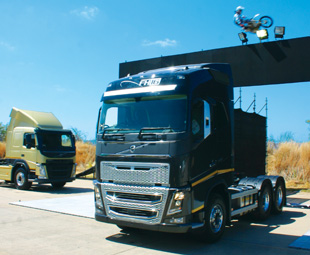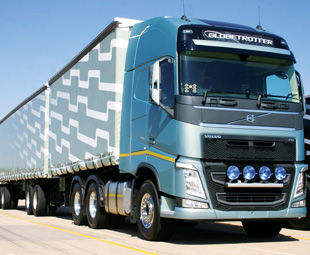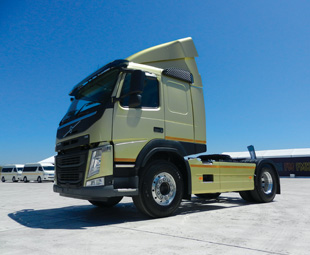Viva Volvo!

It’s not every day that it takes two people to write one article for FOCUS. But, then again, it’s also not every day that a truck manufacturer launches four new model ranges! But that’s exactly what Volvo Trucks Southern Africa did last month. So we despatched two writers – GAVIN MYERS and CHARLEEN CLARKE – to Gerotek to report on proceedings. And it turned into a game of “he said, she said” as they attacked the track and put the new models to the test …
We may have had to wait a year for Volvo’s new FH, and about six months for the FMX, to make it to our shores – but we could’ve told you all those months ago that the wait would be worth it. Well the waiting is now over. Both were launched locally at Gerotek, outside Pretoria, in the middle of October, so the only wait operators now have is for the first week of December – when the order books officially open.
The FH, three-times Truck of the Year recipient, has been designed to be a premium, world-class product that makes the driver’s job easier and more efficient. While also positioned as a premium product, the FMX is, as president of Volvo Trucks Claes Nilsson puts it, the brand’s “action hero” (much like the man himself; he’s often referred to as the company’s stunt man, after standing on a FMX that had been hoisted more than 20 metres above the water in Gothenburg harbour for the making of a movie).
 Both are clearly integral to the success of Volvo – not only here in South Africa but also on the continent at large (with the South African economy accounting for one-third of Africa’s gross domestic product, Volvo knows that succeeding in the local market is of the utmost importance for its full expansion into the continent). The company already has 6 000 trucks operating in the African region and has big plans to expand its network over the coming months. Nilsson is confident that no one can beat the company’s total offer.
Both are clearly integral to the success of Volvo – not only here in South Africa but also on the continent at large (with the South African economy accounting for one-third of Africa’s gross domestic product, Volvo knows that succeeding in the local market is of the utmost importance for its full expansion into the continent). The company already has 6 000 trucks operating in the African region and has big plans to expand its network over the coming months. Nilsson is confident that no one can beat the company’s total offer.
And those new trucks? Well, in our humble opinion, they may just be perfect for the job …
HE SAID
The goal behind the new Volvo FMX, according to Gary Spowart, product and price manager Volvo Southern Africa, was to make the range the best available in the construction market. So what’s the recipe?
It starts with a cab made from high-tensile steel that also features a three-piece bumper with three millimetre steel corner bumpers. The bumper also incorporates the famous 32-tonne cast iron towing hook. Below it is a steel engine guard, which extends under both the engine and the gearbox, and on either side are new, sturdier headlights that also incorporate Volvo’s new signature V-shaped daytime running lights (DRLs) – a first on a construction vehicle.
The interior of the cab has been redesigned as well and, in addition to being logically laid-out, it feels like the premium environment Volvo intends it to be. And this is a construction vehicle … Important features to make the driver’s life easier include the new instrument panel; new multi-function steering wheel-mounted controls; the relocation of the key for extra legroom; new seats with improved tilt, lumbar and side support with 10 mm slimmer seatbacks for improved adjustability; a narrower steering column with improved steering wheel adjustability and, on the 440 8×4 Tridem sleeper-cab model that I drove, perhaps the softest mattress I’ve ever felt.
Indeed, the FMX feels superb from behind the wheel, especially on the rough stuff. There are many reasons for this – one of which, specific to the 8×4, is the hydraulic steering action of the tag axle. This reduces tyre wear, eases steering effort and improves agility – and it works. The FMX 8×4 feels no more difficult to manoeuvre than a large van. Volvo’s famed dynamic steering – a first on trucks – is also available as an option.
 Another reason for the FMX’s impressive manners is its suspension, designed specifically for the construction sector. Volvo offers a choice of rear steel or electronically-controlled air suspension which, Spowart notes, reduces maintenance requirements and lowers CPK. The FMX has a 300 mm ground clearance at its lowest point and the air-suspension system features automatic ride-height control.
Another reason for the FMX’s impressive manners is its suspension, designed specifically for the construction sector. Volvo offers a choice of rear steel or electronically-controlled air suspension which, Spowart notes, reduces maintenance requirements and lowers CPK. The FMX has a 300 mm ground clearance at its lowest point and the air-suspension system features automatic ride-height control.
Motive power comes from either the D11A or D13A Euro-3 powerplants; pushing out between 330 and 430, or 400 and 480 hp (246 and 320 kW, or 298 and 358 kW) respectively. Gross vehicle mass (GVM) ratings range from 21 to 41 tonnes.
With its 2 200 Nm, the 440 hp D13A is a smooth, strong unit. The engine is hooked up to Volvo’s I-Shift 12-speed automated non-synchromesh transmission that also offers some innovative features on the FMX: including rock-free, jerk start and hill climb functions. On “x4” models – available in 4×4, 6×4, 8×4 and 10×4 variants – the front axle has been moved 100 mm forward to improve off-road capability and endurance.
Not that endurance should be a problem – with service intervals for the Euro-3 models at 30 000 km this vehicle is clearly made to go the distance. Volvo is also providing backup and support by way of its Volvo Action Service (VAS) on Call platform, which uses the vehicle’s new electronic structure and a communication unit, known as the Telematics Gateway, which is standard on the FM and FMX range. Through this, parameters pertaining to the vehicle’s condition can be monitored by a remote workshop.
Fault codes can therefore be read before a technician is sent to physically diagnose and repair a stricken vehicle and servicing and maintenance can be scheduled in relation to the condition and use of each individual vehicle. The Telematics Gateway also allows operators to monitor constant updates on the performance of trucks and drivers in commercial fleets via the Dynafleet app.
Through VAS, security for the driver is also increased, connecting the truck to the VAS customer helpdesk. “This automated system saves valuable time and delivers help to the truck driver that much faster,” says Torbjörn Christensson, MD of Volvo Trucks Southern Africa.
In addition, Volvo’s new Gold Service Agreement is a comprehensive maintenance programme formulated by the vehicle manufacturer, designed to minimise maintenance costs. It includes aspects such as service planning, online assistance and VAS.
 It all adds together to make one of the best ranges available in the construction market.
It all adds together to make one of the best ranges available in the construction market.
SHE SAID
Sometimes I love my job. And sometimes I truly adore it. The latter applied when we trundled out to Gerotek for Volvo’s truck launch. That’s because, after yet another lengthy delay due to rude latecomers (this is becoming the norm at media events, it seems), we were treated to a real spectacle (both in terms of entertainment and the actual trucks).
First the entertainment. Incredibly, the Volvo team had erected a massive stage, where an FH was parked in all its glory. After a brief introduction by rugby legend Kobus Wiese (who is almost as big as the FH), two fairly insane bike riders performed death-defying feats, leaping over the stage and the FH, often throwing their feet into the air and only holding onto their bikes’ handlebars.
It was crazy, but hugely entertaining, stuff.
I thought about this later when I was behind the wheel of the FH – because the two scenarios were poles apart. I am sure that the bike riders knew exactly what they were doing – I assume that they were professional stunt riders. After all, Volvo is synonymous with safety; the company would never have organised an event that promoted unsafe behaviour. But I was delighted to be behind the wheel of the truck – it was a much, much safer place to be (the FH is, after all, the safest truck ever produced by Volvo Trucks).
However, before I tell you all about my driving experience, a bit of detail on the new range … In southern Africa, the Volvo FH range will be available in eight model variants, including the truly marvellous FH16 515 kW (700 hp) 8×4 truck tractor. Both 13 and 16-litre engines are available, with outputs ranging from 295 kW (400 hp) to the aforementioned monster 515 kW (700 hp) powerplant. Incidentally, although the company is introducing Euro-3 variants as standard due to current local fuel legislation, Euro-5 and -6 level variants are available on request for fleet owners who wish to utilise this technology.
Now back to the fun stuff: the driving. My first test vehicle was the FH 440, and I partnered with Timothy Sibisi, a driver trainer at Volvo Trucks. Before I hopped behind the wheel, Sibisi took me for a spin around Gerotek, which gave me a chance to examine the functionality of the cab.
 It gets a definite thumbs up – I had heard that the company had chatted to 3 000 drivers from various markets, who provided input and feedback during the development phase, and this really shows because the cab is a great place to be. Stalks and controls are arranged in order of priority so that the most important ones are closest to the driver. All in all, these changes give the driver far better visibility.
It gets a definite thumbs up – I had heard that the company had chatted to 3 000 drivers from various markets, who provided input and feedback during the development phase, and this really shows because the cab is a great place to be. Stalks and controls are arranged in order of priority so that the most important ones are closest to the driver. All in all, these changes give the driver far better visibility.
I also loved all the extra loading spaces, which Sibisi showed to me very proudly. There are gazillions of storage areas, meaning that the cab isn’t full of clutter on a long-haul journey, which is obviously where the FH is right at home.
Sibisi agreed with me that the interior was nothing short of exemplary. “I really like the driving comfort and the fuel efficiency of our new trucks. Plus I would say that it is a really eye-catching truck,” he told me with a huge grin.
When I hopped behind the wheel, I got a taste of that fuel efficiency. But, before proceeding, I ensured that my driving position was ideal. This is easy to achieve – the steering wheel even has a neck tilt function, a first in the world of trucking! But, back to the all-important fuel efficiency. As we were racing around the track, Sibisi was quick to point out the Eco-Roll feature. Essentially, it utilises kinetic energy – the truck’s motion – to make the vehicle more efficient, saving up to two percent in fuel consumption. It actually allows the transmission to disengage the engine in certain situations, such as moderate hills. The vehicle will roll out longer, delaying the need to return power to the engine, obviously saving fuel in the process. It’s a really cool feature.
Speaking of cool, my next experience was right up there on the Seriously Cool Rating: I got to share a truck with Torbjörn Christensson, managing director of Volvo Trucks SA, and another driver trainer by the name of Solomon Ncala. We ended up having so much fun that the rest of the group actually left the test track and went for lunch … and we didn’t even notice.
But I digress. Back to the performance of the truck. I asked Christensson (who was beaming gear to gear as he whizzed around the track) what he liked most about the new vehicles. “Oh there is so much. But I guess that, for me, the interior and handling are the most dramatic improvements. The new Volvo FH offers exceptional handling – pretty much like that of a car. To put things into perspective, we even offer individual front suspension as an option. This world-first takes handling to unsurpassed levels in the truck world. I also like the fact that the cab is so quiet,” he responded. (I fully concurred; we were able to have a marvellous chat without being interrupted by engine or road noise … it was just like sitting in my office.)
 Like me, Christensson is a big fan of the storage space. “One of the biggest complaints we had with the previous range was a lack of storage space. That’s certainly not a concern any more,” he noted.
Like me, Christensson is a big fan of the storage space. “One of the biggest complaints we had with the previous range was a lack of storage space. That’s certainly not a concern any more,” he noted.
Christensson added that he was particularly appreciative of the light and airy cab. “I love the light. Thanks to the sunroof, it’s a lovely place to be,” he commented (and I concurred).
Naturally, he’s ever so chuffed that the new FH will help operators save fuel – because this will obviously bolster sales considerably. “Reducing fuel consumption is a priority for Volvo Trucks. For instance, the range utilises our I-Shift 12-speed mechanical gearbox, which is 70 kg lighter than its manual counterpart. New advancements in I-Shift technology have led to a three percent fuel saving potential and low energy losses. I-Shift is always in the right gear for the situation at hand, making it extremely precise and cost effective,” Christensson pointed out.
Of course, features such as I-Shift also mean that the vehicle is very easy to drive. “Even my grandmother could drive this truck,” he noted with a big grin. “Although she may battle with the reversing.”
Eventually we realised that we had been abandoned, and decided that we should rejoin the rest of the group. But, before hopping out of the cab, I just had to ask Ncala what he thought about the new FH. “I have been with Volvo for 20 years and I have never experienced anything like this before. This one, she is lovely,” he said, with a genuinely delighted beam.
I don’t think I could put it better myself.
Published by
Focus on Transport
focusmagsa




